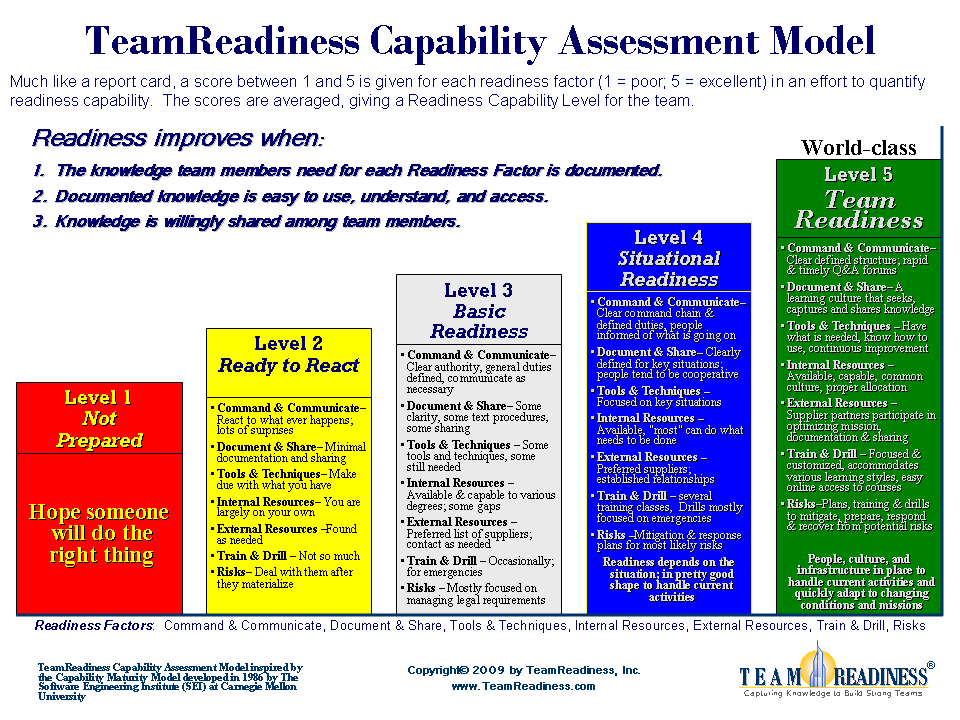20 Questions: A Quick-Start Assessment of Your Team’s Readiness Capability
It can be helpful to occasionally stop and take inventory of your team’s readiness capability. A team achieves readiness when each individual member can do his or her job — correctly, on time, within budget, safely, and as expected. Achieving team readiness means that jobs get done in the right way and with the desired results. Team members must have the proper know-how and ability to perform their duties. And they must conduct themselves with the appropriate behavior.
The TeamReadiness® Capability Assessment Model is a self-diagnostic framework to help assess an organizations’ or teams’ ability to optimally carry-out its mission. The model examines seven factors that seem most correlated with readiness capability (based on TeamReadiness® implementations and benchmarking). Each factor is evaluated and assigned a score from 1 (poor) to 5 (excellent) to quantify Readiness Capability. The model can be used to help team’s understand where they are, and chart a course for where they want to go, to achieve team readiness.
(Click image to enlarge)
In an effort to design a “quick” assessment of the qualities and characteristics needed by teams to achieve readiness, we looked at different practices from our own experience as well as disciplines including:
- Project Management
- Team Building and Team Dynamics
- Learning Organizations
- Employee Engagement
- Emergency and Risk Management
What follows are 20 questions that you can answer to assess the readiness capability of your team. For each question, consider how well your team meets the general criteria shown and give a score between 1 (poor) and 5 (excellent). You may need to modify the criteria to fit the specific needs of your team. For scores less than 5, consider what you might do to improve your team’s readiness capability.
TeamReadiness
| A. Command & Communicate | |||
|---|---|---|---|
| # | Question | Criteria | Score |
| 1. | Does the Team have a good leader? |
|
1 to 5 |
| 2. | Does the team have a good workplan? |
|
1 to 5 |
| 3. | Does each team member know what is expected of them and why it needs to be done? |
|
1 to 5 |
| 4. | Does each team member know how to do their jobs? |
|
1 to 5 |
| 5. | Does the team have a good process for decision making? |
|
1 to 5 |
| 6. | Does the team do a good job of communicating information? |
|
1 to 5 |
| 7. | Does the team have a good process of empowerment & accountability? |
|
1 to 5 |
| 8. | Does the team meet regularly to review and discuss progress? |
|
1 to 5 |
| B. Document & Share | |||
| # | Question | Criteria | Score |
| 9. | Do team members readily and openly share their knowledge and experience with other team members? |
|
1 to 5 |
| 10. | Do team members document their knowledge using computer or online tools so it can be preserved and referenced by others? |
|
1 to 5 |
| C. Tools & Techniques | |||
| # | Question | Criteria | Score |
| 11. | Does the Team use formal, proven, and agreed upon methods for problem solving and accomplishing tasks? |
|
1 to 5 |
| 12. | Do team members know how to use the tools & techniques they need to do their jobs? |
|
1 to 5 |
| 13. | Are tools & techniques in place to give team members situational awareness during a mission, while performing a procedure, or while conducting an operation? |
|
1 to 5 |
| D. Internal Resources | |||
| # | Question | Criteria | Score |
| 14. | Are there sufficient internal resources available to assist team members with their job? |
|
1 to 5 |
| E. External Resources | |||
| # | Question | Criteria | Score |
| 15. | Would your suppliers say that your team members work well with them to get the job done? |
|
1 to 5 |
| 16. | Would your team members say that your suppliers work well with them to get the job done? |
|
1 to 5 |
| F. Train & Drill | |||
| # | Question | Criteria | Score |
| 17. | Are there online, always accessible, and easy-to-understand training materials focused on the specific jobs that team members perform? |
|
1 to 5 |
| 18. | Is your training program easy to administer and automated, ensuring that team members get the specific training they need, when they need it, with minimum overhead and hassle? |
|
1 to 5 |
| G. Risk Management | |||
| # | Question | Criteria | Score |
| 19. | Has the team adequately mitigated, but also prepared for, likely failures associated with process and procedure execution (e.g., machine breaks down, a key person quits, etc.)? |
|
1 to 5 |
| 20. | Has the team adequately mitigated, but also prepared for, likely man-made attacks (e.g., theft, fire, computer hacker, etc.) and also likely natural disasters (e.g., flood, tornado, etc.)? |
|
1 to 5 |

|
Let TeamReadiness help. We can assist with the entire process to quickly and cost effectively help team members grow their capabilities and achieve team readiness!
|
|---|
DMW
Copyright © 2007-2012 TeamReadiness, Inc.





